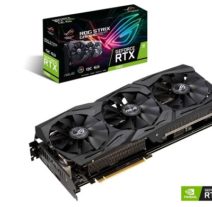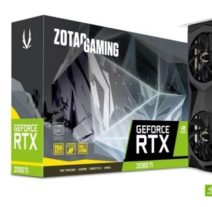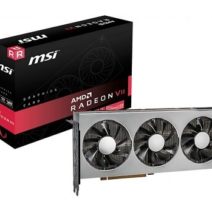
Summary
- TOP VR READY GRAPHICS CARDS
- Gigabyte Geforce GTX 1660 OC: low budget with big muscles
- MSI Geforce GTX 1660 Gaming X: a dazzling CG
- Zotac Geforce GTX 1660 Ti AMP: place au confort
- ZOTAC_GAMING_GeForce_GTX_1660_Ti_AMP
- Gigabyte Geforce GTX 1660 Ti Gaming OC
- EVGA Geforce RTX 2060 XC Ultra Gaming: let's avoid compromises
- evga geforce rtx 2060 xc ultra gaming
- ASUS Geforce RTX 2060 ROG STRIX OC
- asus rtx 2060 rog strix oc vr ready graphics card
- Gigabyte Geforce RTX 2070 Windforce: the best value for money
- MSI Geforce RTX 2070 Gaming Z
- KFA2 (GALAX) RTX 2080 EX 1-Click OC
- rtx 2080 kfa2
- MSI RTX 2080 Gaming X Trio: country of compromises lives in the ULTRA VR
- msi rtx 2080 gaming trio graphics card vr ready
- ZOTAC Geforce RTX 2080 Ti Twin Fan
- rtx geforce rtx 2080 ti twin fan
- ASUS Geforce RTX 2080 Ti ROG STRIX OC Gaming: Why Spend Less?
- Sapphire Radeon RX 580 Nitro +: the minimum to play in VR
- Sapphire Radeon RX 590 Nitro +: a bit better
- Gigabyte Radeon RX Vega 56 Gaming OC
- gigabyte radeon rx vega 56 gaming oc
- Sapphire Radeon RX Vega 64 NITRO +: an alternative to the RTX 2070
- MSI Radeon VII: a technological first
- Msi radeon vii
- VR READY GRAPHIC CARD PURCHASING GUIDE
- Power supply: THE number one criterion in choosing a VR Ready graphics card
- Size: it matters
- Ventilation: Silence and freshness
- Drivers: up to date or not up to date?
- Bottleneck : kézako ?
- SLI / Crossfire: How about two cards?
- The opportunity / marketplaces: precautions to take
Keeping your computer up to date is crucial for getting the most out of VR games and applications. Obviously, the main component of the operation of your HTC, Oculus, Valve or Windows Mixed Reality headset is none other than the VR Ready graphics card. In this comparison, we bring you a selection of the best VR Ready graphics cards on the market.
To make this selection, we base ourselves on the minimum specifications offered by the helmet manufacturers. Here is what it appears on the manufacturers' sheets:
Oculus Rift S :
- Processor: Intel Core i3-6100 / AMD Ryzen 3 1200, FX4350 or better
- Graphics card: NVIDIA GeForce GTX 1050Ti / Radeon RX 470 or better
- RAM: 8 Go
- 1 port USB 3.0
- Windows 10
HTC Vive:
- Processor: Intel i5-4590, AMD FX 8350 or better
- Graphics card: Nvidia GeForce GTX 970, AMD Radeon R9 290 or better
- RAM: 4 Go
- 1 port USB 2.0 or higher, HDMI 1.4, DisplayPort 1.2 or higher,
- Windows 7, 8 or 10
HTC Vive Pro:
- Intel Core i5-4590 / AMD FX 8350 or better
- Graphics card: NVIDIA GeForce GTX 1070 / Quadro P5000, AMD Radeon Vega 56 or better
- RAM: 4 GB or more
- 1 port USB 3.0 or higher, DisplayPort 1.2 or higher,
- Windows 10
Valve Index :
- Dual Core avec Hyper-Threading
- Graphics card: NVIDIA GTX 970 / AMD RX480
- RAM: 8 GB or more
- 1 USB 2.0 port AND 1 DysplayPort required
- Windows 10
Windows Mixed Reality :
- Processor: Intel Core i5 4590, AMD Ryzen 5 1400 or better
- Graphics Card: NVIDIA GTX 1060
- RAM: 8 Go
- 1 port USB 3.0, HDMI 1.4, DisplayPort 1.2 or higher,
- Windows 10 Fall Creators or higher
- 15 inch or larger screen
These are minimum recommendations. Most headsets need a powerful processor like the Intel Core i5 9600K or the AMD Ryzen 5 2600X to perform at their best. Opt directly for 16 GB of RAM for more generosity. An Intel Core i7 may be interesting, but its current price in 2019 does not necessarily justify the purchase. No, save your money for the VR Ready graphics card.
Note that most manufacturers mention components that are no longer for sale or in the process of destocking, such as the GTX 1060, 1070, 1070 Ti, 1080 or even 1080 Ti series. If your budget is tight why not turn to the second hand market. We prefer to advise you to take a new card, then change it every two to three years by reselling the previous one.
Consult our guide to building a VR Ready PC
TOP VR READY GRAPHICS CARDS
Gigabyte Geforce GTX 1660 OC: low budget with big muscles

The Taiwanese manufacturer Gigabyte is used to declining its models in different ranges. In France, we have access to the Geforce GTX 1660 OC and its Gaming OC version. The one we have chosen has the advantage of being shorter, 22 cm against 28 cm for very slightly lower performance. The Gaming model is equipped in return with three fans.
Don't worry, the Windforce design with two propellers gives good results: the board climbs to a maximum of 72 degrees according to TechRadar tests. The semi-passive mode cuts the air flow below 50 degrees Celsius. The performance is just a bit below a GTX 1070 for an unbeatable price. This VR Ready graphics card will be perfect for playing with an Oculus Rift or Rift S and will be able to run most titles on the HTC Vive. We advise you to combine it with a Ryzen 5 2600 processor so as not to suffer from bottlenecks. The PC in question will cost around 750 euros.
- Maker : Gigabyte
- Overclockée : Yes
- VRAM : 6GB GDDR5
- Memory interface: Bits 192
- Boosted Chipset Frequency: 1830 MHz
- Memory frequency: 8000 MHz
- Power connector (s): 1XPCI Express 8 pin
- Video outputs: 3 x DisplayPort Female 1.4, 1 HDMI 2.0 Female
- Length: 224 mm
- Format : Dual Slot
- Consumption: 135 Watts
- Recommended diet: 450 Watts 80+ Bronze
- Price: From 249,95 €
MSI Geforce GTX 1660 Gaming X: a dazzling CG

Here again, MSI offers an original overclocked VR Ready graphics card for maximum power. Slightly more efficient than the previous one, it has a metal backplate which allows it not to deform under its weight over time.
Likewise, heat dissipation is improved. Tom's Hardware testers see a maximum temperature of 61 degrees after a 4K gaming session on The Witcher 3. Low noise, the Gaming X also offers RGB lights for those who want to visually customize their configuration. Its price necessarily climbs to 800 euros minimum. You also gain a few frames per second.
- Maker : MSI
- Overclockée : Yes
- VRAM : 6GB GDDR5
- Memory interface: Bits 192
- Boosted Chipset Frequency: 1860 MHz
- Memory frequency: 8000 MHz
- Power connector (s): 1XPCI Express 8 pin
- Video outputs: 3 x DisplayPort Female 1.4, 1 HDMI 2.0 Female
- Length: 247 mm
- Format : Dual Slot
- Consumption: 130 Watts
- Recommended diet: 450 Watts 80+ Bronze
- Price: From 299 €
Zotac Geforce GTX 1660 Ti AMP: place au confort
Zotac is a bit like our favorite brand. We own a VR Ready graphics card from this brand. The advantage? Extended warranty up to 5 years. Additionally, this model provides solid performance in most VR or non-VR video games. It exceeds the GTX 10 by nearly 1070 frames per second in most of the titles observed.
This very short and sober model allows you to create a powerful mini PC capable of supporting all the titles in your VR catalog.. In terms of temperature, the board climbs to 74 degrees under load and maintains 40 degrees at rest.
- Maker : Zotac
- Overclockée : Yes
- VRAM : 6GB GDDR6
- Memory interface: Bits 192
- Boosted Chipset Frequency: 1860 MHz
- Memory frequency: 12 000 MHz
- Power connector (s): 1XPCI Express 8 pin
- Video outputs: 3 x DisplayPort Female 1.4, 1 HDMI 2.0 Female
- Length: 209 mm
- Format : Dual Slot
- Consumption: 130 Watts
- Recommended diet: 500 Watts 80+ Bronze
- Price: From 320 €
Gigabyte Geforce GTX 1660 Ti Gaming OC
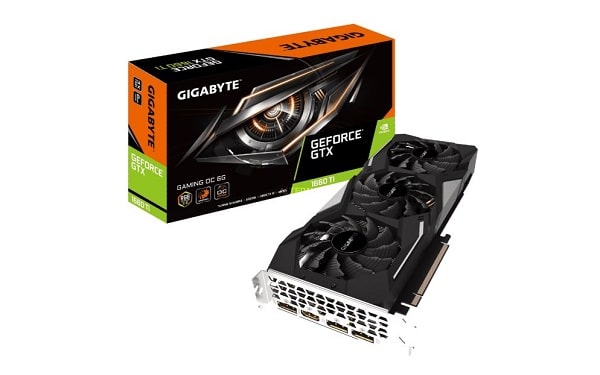
This is surely the most powerful GTX 1660 Ti available on the market. Here, Gigabyte is playing on its 3 fan model to drop the temperature at rest to 37 degrees and 65 degrees under load. A nice result. Moreover, it displays results between the GTX 1070 and the 1080. Be careful of its size though.
Its 28 centimeters require a fairly large case. We recommend that you install it in a chassis that offers a minimum spacing of 33 cm for the graphics card. This normally leaves you room to pass the various cables and not impact the ventilation of the other components.
- Maker : Gigabyte
- Overclockée : Yes
- VRAM : 6GB GDDR6
- Memory interface: Bits 192
- Boosted Chipset Frequency: 1860 MHz
- Memory frequency: 12 000 MHz
- Power connector (s): 1XPCI Express 8 pin
- Video outputs: 3 x DisplayPort Female 1.4, 1 HDMI 2.0 Female
- Length: 280 mm
- Format : Dual Slot
- Consumption: 160 Watts
- Recommended diet: 500 Watts 80+ Bronze
- Price: From 340 €
EVGA Geforce RTX 2060 XC Ultra Gaming: let's avoid compromises
EVGA may not be the best known brand in Europe. Most consumers don't have too many questions and trust MSI marketing. However, competitors offer interesting products like this VR Ready graphics card from the brand mentioned above. As the name suggests, we are no longer there to mess around, but to provide the means to play in VR in an optimal way.
Here, the HTC Vive, its Pro version and the Oculus Rift variants will perform wonderfully. In terms of temperatures, it does not exceed 40 degrees at rest and 70 degrees under load. Without flinching, this GPU equals the performance of a GTX 1080. And again, the Overclocking capabilities of EVGA products give you the headroom to grab precious frames per second.
- Maker : EVGA
- Overclockée : Yes
- VRAM : 6GB GDDR6
- Memory interface: Bits 192
- Boosted Chipset Frequency: 1830 MHz
- Memory frequency: 14 000 MHz
- Power connector (s): 1XPCI Express 8 pin
- Video outputs: 2 x DisplayPort Female 1.4, 1 DVI Female, 1 HDMI 2.0 Female
- Length: 269 mm
- Format : Dual Slot
- Consumption: 175 Watts
- Recommended diet: 550 Watts 80+ Gold
- Price: From 440 €
ASUS Geforce RTX 2060 ROG STRIX OC
With its Republic of Gamers range, Asus likes to titillate fans of overcloking. If on paper, this VR Ready graphics card takes the technical sheet of the EVGA model, it actually offers the performance of a factory RTX 2070. In other words, this monster of 30 centimeters requires two power rails and no longer just one.
The three 90mm diameter fans keep the board below 60 degrees even under load. They switch off when the temperature drops below 50 degrees. Clearly, it presents itself as a better option than the first prices in the upper range. Hats off to Asus. Small counterpart all the same, it is not as quiet as the other products of the brand.
- Maker : Asus
- Overclockée : Yes
- VRAM : 6GB GDDR6
- Memory interface: Bits 192
- Boosted Chipset Frequency: 1830 MHz
- Memory frequency: 14 000 MHz
- Power connector (s): 1XPCI Express 8 pin, 1XPCI 6 pin
- Video outputs: 2 x DisplayPort Female 1.4, 1 DVI Female, 1 HDMI 2.0 Female, 1 USB type C
- Length: 300 mm
- Format : Dual Slot
- Consumption: 180 Watts
- Recommended diet: 550 Watts 80+ Gold
- Price: From 499 €
Gigabyte Geforce RTX 2070 Windforce: the best value for money
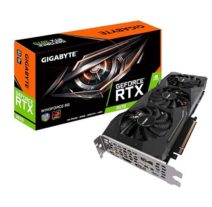
Gigabyte VR Ready graphics cards typically take the entry-level place in each of the categories detailed here. The RTX 2070 Windforce is no exception to the rule. This large card has three fans to keep the temperature below 70 degrees under load. A completely honorable performance. Most games can be upgraded to ultra for a beautiful look. Here, the compromises are minimal. This component takes the characteristics of the Founder Edition which is similar to the powerful 1080 Ti.
Please note, the overall consumption of the configuration goes to 320 Watts under load. As much as a big freezer. Another small detail, the semi-passive function is triggered at 55 degrees. It is better to deactivate it and adjust the fan trigger thresholds yourself. However, this VR Ready graphics card has the best quality / price ratio in this comparison.
- Maker : Gigabyte
- Overclockée : Yes
- VRAM : 8GB GDDR6
- Memory interface: Bits 256
- Boosted Chipset Frequency: 1620 MHz
- Memory frequency: 14 000 MHz
- Power connector (s): 1XPCI Express 8 pin, 1XPCI 6 pin
- Video outputs: 3 x DisplayPort Female 1.4, 1 HDMI 2.0 Female, 1 USB type C
- Length: 280 mm
- Format : Dual Slot
- Consumption: 225 Watts
- Recommended diet: 600 Watts 80+ Gold
- Price: From 530 €
MSI Geforce RTX 2070 Gaming Z

1,4 kilograms on the scale. This 30,5 cm behemoth offers the Twin Frozr 7, a super efficient and quiet cooling system. The boosted chipset frequency allows it to offer performance only 14% lower than the RTX 2080. Like the Gaming X, it stands out with its design and its slightly bling-bling LED lighting. The overclocking possibilities give you the headroom to gain even more valuable FPS. Some might be concerned about his weight.
Do not worry. MSI has thought of everything and provides a square to avoid bending your motherboard. This luxurious product is arguably the best RTX 2070 on the market.
- Maker : MSI
- Overclockée : Yes
- VRAM : 8GB GDDR6
- Memory interface: Bits 256
- Boosted Chipset Frequency: 1830 MHz
- Memory frequency: 14 000 MHz
- Power connector (s): 1XPCI Express 8 pin, 1XPCI 6 pin
- Video outputs: 3 x DisplayPort Female 1.4, 1 HDMI 2.0 Female, 1 USB type C
- Length: 307 mm
- Format : Dual Slot
- Consumption: 225 Watts
- Recommended diet: 600 Watts 80+ Gold
- Price: From 669 €
KFA2 (GALAX) RTX 2080 EX 1-Click OC
KFA2, better known as Galax outside of Europe, offers VR Ready graphics cards at rock bottom prices, but which offer decent performance. The RTX 2080 EX 1-Click OC takes up the capabilities of the Founder Edition exactly. Unfortunately, the performance is slightly lower than this benchmark model.
In terms of cooling, the brand relies on two fans that maintain the card under 75 degrees in load and under 30 degrees (!) at rest. We regret its somewhat noisy operation at full power, but its price, 669 euros, will quickly make you forget this defect. A good compromise for VR gaming sessions without asking any questions.
- Maker : KFA2
- Overclockée : Yes
- VRAM : 8GB GDDR6
- Memory interface: Bits 256
- Boosted Chipset Frequency: 1755 MHz
- Memory frequency: 14 000 MHz
- Power connector (s): 1XPCI Express 8 pin, 1XPCI 6 pin
- Video outputs: 3 x DisplayPort Female 1.4, 1 HDMI 2.0 Female, 1 USB type C
- Length: 295 mm
- Format : Dual Slot
- Consumption: 240 Watts
- Recommended diet: 600 Watts 80+ Gold
- Price: From 669 €
MSI RTX 2080 Gaming X Trio: country of compromises lives in the ULTRA VR
MSI still offers here a titanic VR Ready graphics card. Three fans bring the temperature down to 70 degrees on load without a sound, while your eyes will say thank you in any VR game. Solid backplate, weight 1,2 kg, allows you to play most of your titles in 4K 60 FPS. That is to say.
On the other hand, it is better to accompany it well. A 650 Watts Gold certified power supply and an Intel Core i7 (8700K, 9700k) or AMD Ryzen 7 2700X processor, or even ThreadRipper are required so as not to slow down the beast unnecessarily. Likewise, its size requires a good size case. For this, we recommend the Cooler Master, NZXT, Fractal Design or Corsair products. These manufacturers are used to leaving a large space for the on-board graphics card (s).
- Maker : MSI
- Overclockée : Yes
- VRAM : 8GB GDDR6
- Memory interface: Bits 256
- Boosted Chipset Frequency: 1860 MHz
- Memory frequency: 14 000 MHz
- Power connector (s): 2XPCI Express 8 pin
- Video outputs: 3 x DisplayPort Female 1.4, 1 HDMI 2.0 Female, 1 USB type C
- Length: 327 mm
- Format : Dual Slot
- Consumption: 250 Watts
- Recommended diet: 650 Watts 80+ Gold
- Price: From 839 €
ZOTAC Geforce RTX 2080 Ti Twin Fan
Zotac uses the same characteristics here as the technical sheet sent by Nvidia. There are two fans that keep the card at 76 degrees in load and 40 degrees at rest. The noise is quickly forgotten because the level is perfectly acceptable.
Performance is particularly solid allowing you to get the most out of your games and VR experiences. In Europe, you will hardly find a cheaper RTX 2080 TI in Europe. Considering the capabilities, you'll never run out of power with this VR graphics card.
- Maker : Zotac
- Overclockée : No
- VRAM : 11 GB GDDR6
- Memory interface: Bits 352
- Boosted Chipset Frequency: 1545 MHz
- Memory frequency: 14 000 MHz
- Power connector (s): 2XPCI Express 8 pin
- Video outputs: 3 x DisplayPort Female 1.4, 1 HDMI 2.0 Female, 1 USB type C
- Length: 268 mm
- Format : Dual Slot
- Consumption: 250 Watts
- Recommended diet: 650 Watts 80+ Gold
- Price: From 1069 €
ASUS Geforce RTX 2080 Ti ROG STRIX OC Gaming: Why Spend Less?
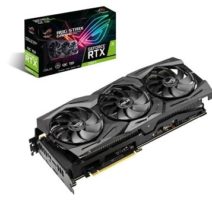
Here we are addressing extensible purses, performance fanatics who will not shy away from any expense. At this level, we can say that it is total abuse. This model is more efficient than the Founder Edition, which is already well boosted. Here, 4K 60 FPS is a formality in most games. Such a card reinforced by its blackplate offers golden silence (or practically) thanks to its Quiet mode.
Temperatures remain higher than usual: 81 degrees under load, but the fan shuts off below 55 degrees. Once again, the name ROG Strix ensures a sympathetic aesthetic oriented Gamer with an arobase.
- Maker : ASUS
- Overclockée : Yes
- VRAM : 11 GB GDDR6
- Memory interface: Bits 352
- Boosted Chipset Frequency: 1665 MHz
- Memory frequency: 14 000 MHz
- Power connector (s): 2XPCI Express 8 pin
- Video outputs: 2 x DisplayPort Female 1.4, 2 HDMI 2.0 Female, 1 USB type C
- Length: 304 mm
- Format : Dual Slot
- Consumption: 250 Watts
- Recommended diet: 650 Watts 80+ Gold
- Price: From 1499 €
Sapphire Radeon RX 580 Nitro +: the minimum to play in VR

This RX580 is nothing but a rebadging of the RX480, a model that allowed you to indulge in VR with most Oculus games. Indeed, this model is reserved for owners of a Rift not too demanding on graphic details.
However, it is sometimes more powerful than the GTX 1060, which is a guarantee of quality for VR. We don't forget the supersampling here. The cooling is of quality both in terms of noise and temperature of 76 degrees maximum despite a not very playful heatsink.
- Maker : Sapphire
- Overclockée : Yes
- VRAM : 8 GB GDDR5
- Memory interface: Bits 256
- Boosted Chipset Frequency: 1411 MHz
- Memory frequency: 2 000 MHz
- Power connector (s): 1XPCI Express 8 pin 1XPCI Express 6 pin
- Video outputs: 2 x DisplayPort Female 1.4, 2 HDMI 2.0 Female, 1 DVI-D dual link
- Length: 260 mm
- Format : Dual Slot
- Consumption: 230 Watts
- Recommended diet: 600 Watts 80+ Bronze
- Price: From 209 €
Sapphire Radeon RX 590 Nitro +: a bit better
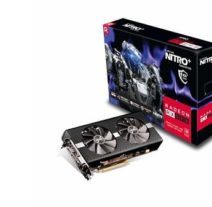
If you can't find an RX 590 and you absolutely want to take an AMD card then go for this RX590. Unfortunately, this GPU does not offer a very significant boost: 11%. On the other hand, the power consumption increases forcing you to take at least a 600 Watt power supply. The cooling system ensures the same performance as its little sister.
- Maker : Sapphire
- Overclockée : Yes
- VRAM : 8 GB GDDR5
- Memory interface: Bits 256
- Boosted Chipset Frequency: 1560 MHz
- Memory frequency: 2100 MHz
- Power connector (s): 1XPCI Express 8 pin 1XPCI Express 6 pin
- Video outputs: 2 x DisplayPort Female 1.4, 2 HDMI 2.0 Female, 1 DVI-D dual link
- Length: 260 mm
- Format : Dual Slot
- Consumption: 250 Watts
- Recommended diet: 600 Watts 80+ Bronze
- Price: From 279 €
Gigabyte Radeon RX Vega 56 Gaming OC
Hard to find, the RX Vega 56 from Gigabyte remains very interesting. For less than 300 euros, this model offers the performance of a boosted GTX 1070, or even a 2060. Thanks HBM2 memory. The silence is golden with 36 Db measured. The maximum temperature of 75 degrees could be lower, but you only need to manually push the knobs to gain a few degrees.
- Maker : Gigabyte
- Overclockée : Yes
- VRAM : 8GB HBM2
- Memory interface: Bits 2048
- Boosted Chipset Frequency: 1501 MHz
- Memory frequency: 800 MHz
- Power connector (s): 2XPCI Express 8 pin
- Video outputs: 3 x DisplayPort Female 1.4, 3 HDMI 2.0 Female
- Length: 273 mm
- Format : Dual Slot
- Consumption: 250 Watts
- Recommended diet: 650 Watts 80+ Gold
- Price: From 309 €
Sapphire Radeon RX Vega 64 NITRO +: an alternative to the RTX 2070

With its long PCB and three fans, the Shapphire Nitro + Radeon RX Vega 64 shows 80 degrees under load. It may sound like a lot, but the components, far from the danger of malfunction, perform their best. As powerful as an RTX 2070, the Vega 64 remains a benchmark even two years after its release. Quiet, its only flaw is high power consumption.
- Maker : Sapphire
- Overclockée : Yes
- VRAM : 8GB HBM2
- Memory interface: Bits 2048
- Boosted Chipset Frequency: 1580 MHz
- Memory frequency: 945 MHz
- Power connector (s): 2XPCI Express 8 pin
- Video outputs: 2 x DisplayPort Female 1.4, 2 x HDMI 2.0 Female
- Length: 310 mm
- Format : Dual Slot
- Consumption: 327 Watts
- Recommended diet: 650 Watts 80+ Gold
- Price: From 419 €
MSI Radeon VII: a technological first
It is the first graphics processor engraved in 7nm. This model competes with the 2080 with very similar performance in terms of cooling as well as frames per second.
This interesting alternative has the drawback of making the noise of the level of a running dishwasher. For a VR Ready graphics card, that's too much. On the other hand, hackers will appreciate to combine it with a water-cooling system to gain in efficiency.
- Maker : MSI
- Overclockée : Yes
- VRAM : 16GB HBM2
- Memory interface: Bits 4096
- Boosted Chipset Frequency: 1750 MHz
- Memory frequency: 1000 MHz
- Power connector (s): 2XPCI Express 8 pin
- Video output: 3 x DisplayPort Female 1.4, 1 HDMI 2.0 Female
- Length: 267 mm
- Format : Dual Slot
- Consumption: 300 Watts
- Recommended diet: 650 Watts 80+ Bronze
- Price: From 779 €
VR READY GRAPHIC CARD PURCHASING GUIDE
Here is a list of valuable tips for choosing your VR Ready graphics card. Regulars will find some useful reminders here.
Power supply: THE number one criterion in choosing a VR Ready graphics card
Have you ever blown your house? You wouldn't like that to happen with graphics card. Taking an undersized power supply for this component endangers your entire PC. We therefore advise you to follow the advice of the manufacturers. The price of power supplies has fallen significantly. An 80+ Gold certified model is now available below the 70 euros mark. Likewise, the number of PCIe cords tells you if the component will hold a load. So remember to read this criterion on the sheets that we have concocted.
We were pretty generous in power. A good SEASONIC 500 Watts 80+ Bronze model will suffice for the 1660/1660 Ti, but then you need at least a Gold certification. For the rest, we offer the 550, 600 and 650 Watts Gold models from Seasonic, Cooler Master or BeQuiet which offer quality outputs.
Modular models are very interesting because they do not allow cables to hang around everywhere and therefore optimize cooling.
Size: it matters
Have you ever seen a Ferrari engine in a Twingo? Ah yes, it may be possible, but we must strengthen the frame and cut the jail. To avoid the hassle of mounting Mad Max V8 style, turn to the most generous case manufacturers with VR Ready graphics cards.
We mainly think of Cooler Master, NZXT and Corsair. As a general rule, we do not recommend any case with a space allowance of less than 330mm for the CG. For our part, we like the “boxes” which offer you to remove the HDD cage to save space like our dear HAF 912 Plus (sniff it is no longer for sale).
Ventilation: Silence and freshness
It is the sinews of war. A well-ventilated VR Ready graphics card is the guarantee that it will perform better and for longer. Hence our indications concerning this data. Having several fans also allows the air flow to be directed and thus even more efficient. Don't do the stupidity of blowing your diet on CG. We do not cross b * rdel flows! Above all, you run the risk of overheating the two components.
Drivers: up to date or not up to date?
In general, we advise you to always make the updates offered by Nvidia and AMD. However, it sometimes happens that some of them lower your performance in games. Therefore, feel free to downgrade if possible and wait for a stable version.
If that still doesn't work, shut down your computer, unplug the graphics card from its PCI Express 3.0 slot (always 16x) and PCIe cords after removing the recalcitrant driver. You just have to put the card back to try the experiment again and reinstall everything. If the bios is failing, check with the manufacturer of your graphics card which will surely have a solution.
Bottleneck : kézako ?
Ah the famous bottleneck. If your processor isn't powerful enough, there's no point in taking a big CG. As in life, balance in this couple is essential. With a GTX 1660 or RX 580, an i5 or Ryzen 5 will do. With the RTX 2060/2070 and the RX Vega 56/64, favor the Intel Core i5 8400, Ryzen 5 2600 / X, and the i5 9600K. Beyond that, the cards will be more comfortable with an i7 8700K, 9700k and the Ryzen 2700X, or even an AMD Threadripper model.
SLI / Crossfire: How about two cards?
Combining two graphics processors seems interesting when using a VR headset. The HTC Vive supports it pretty well, but that doesn't in itself improve the graphics.. A second Nvidia GPU will support PhysX (a physics management engine) and supersampling giving the illusion of a constant image flow (90 FPS). A model of the opposing team will only support this second functionality. On the other hand, forget about SLI / Crossfire with an Oculus Rift, the Facebook subsidiary advises to deactivate the second card in VR. Not glop not glop.
The opportunity / marketplaces: precautions to take
Your budget does not allow you to buy one of the products in this comparison. Never mind, there is still the opportunity and the marketplaces. You can find the very efficient GTX 1070, 1080 and 1080 Ti at great prices. Be careful though: check the seller's reputation when possible. Ask if the card was not used to mine cryptocurrency.
With the fall in prices, miners are mass-reselling machines that have been running at full speed for weeks on end. Worse, some models have no IO. It is therefore impossible to connect headphones to it. Likewise, avoid questionable platforms like Wish, which offers superb scams at prices defying all competition.






